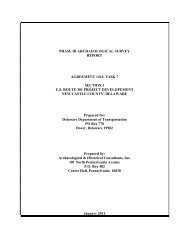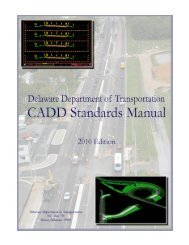Gulph Creek Stone Arch Bridge - Delaware Department of ...
Gulph Creek Stone Arch Bridge - Delaware Department of ...
Gulph Creek Stone Arch Bridge - Delaware Department of ...
You also want an ePaper? Increase the reach of your titles
YUMPU automatically turns print PDFs into web optimized ePapers that Google loves.
Chapter 3—Historic Context for Common Historic <strong>Bridge</strong> Types<br />
3.2.10 Reinforced Concrete Hinged <strong>Arch</strong><br />
History and Description: Hinged concrete arch bridges began to be built early in<br />
the twentieth century, flourished during the 1920s, peaked during the 1930s, and waned<br />
by the time America entered the Second World War. Engineers were trying to achieve a<br />
thin sinuous arch rib that used less material, theoretically lowering construction costs.<br />
European bridges, like those designed by Robert Maillert and Eugene Freyssinet, best<br />
illustrate what designers were seeking in hinged concrete arches. But, in the United<br />
States, with the exception <strong>of</strong> some <strong>of</strong> Oregon State Engineer Conde McCullough’s<br />
Oregon bridges, bridge designers opted for more conservative, heavier arches with<br />
standard reinforcing patterns.<br />
The use <strong>of</strong> hinges simplified the design <strong>of</strong> bridges by allowing stresses in the<br />
arches to be calculated as if the bridge behaved as a statically determinate structure,<br />
which is much simpler mathematically than a statically indeterminate structure. Hinges<br />
also allowed for incremental movement and settlement as the concrete cured. Once the<br />
concrete had cured and the hinges were cemented in, the bridge behaved as a fixed arch.<br />
Hinged reinforced concrete arch bridges may be differentiated by the degree <strong>of</strong><br />
articulation <strong>of</strong> the arch. When there are hinged bearings at each end <strong>of</strong> the arch, the span<br />
is a two-hinged arch. When there are hinged bearings at each end <strong>of</strong> the arch and a hinge<br />
at the crown <strong>of</strong> the arch, the span is a three-hinged arch. The three-hinged arch is the<br />
sub-type most likely to be found in reinforced concrete arch bridges. Span lengths were<br />
<strong>of</strong> an intermediate length, ranging from 100 feet for earlier examples to 230 feet by the<br />
1930s.<br />
Condit (3, p. 176), in discussing reinforced concrete, stated “one other innovation<br />
served to round out the development <strong>of</strong> construction up to the end <strong>of</strong> the [nineteenth]<br />
century.” He then mentions a proposal made by David A. Molitor in 1894 for a threehinged<br />
concrete arch bridge with pinned steel connections, which was never erected, but<br />
goes on to state that “the first arch <strong>of</strong> this kind was built at Mansfield, Ohio, between<br />
1903 and 1904.” However, The Ohio Historic <strong>Bridge</strong> Inventory, Evaluation, and<br />
Preservation Plan (24, p. 99) indicates that the first three-hinged concrete arch bridge in<br />
the United States was a footbridge across Big <strong>Creek</strong> in Brookside Park, Cleveland, Ohio,<br />
designed by Assistant Park Engineer A. W. Zesiger and completed in 1906.<br />
Although the 1906 bridge has been demolished, an approximately 66 foot-long<br />
stone faced, concrete hinged arch bridge built over the same creek in the park in 1909<br />
still exists. Identified as the Brookside Park <strong>Bridge</strong> in the HAER Collection, it may more<br />
properly be called the Big <strong>Creek</strong> <strong>Bridge</strong> to differentiate it from other Brookside Park<br />
bridges, which were listed in the NRHP as a group in 1977. It is an early Melan-style<br />
pedestrian bridge with embedded plates, angles, steel shafting, and cast-iron bearing<br />
plates.<br />
The earliest extant three-hinged reinforced concrete arch bridge in the nation is<br />
the Ross Drive <strong>Bridge</strong> in Rock <strong>Creek</strong> Park, Washington, DC. Originally built in 1907,<br />
3-77






